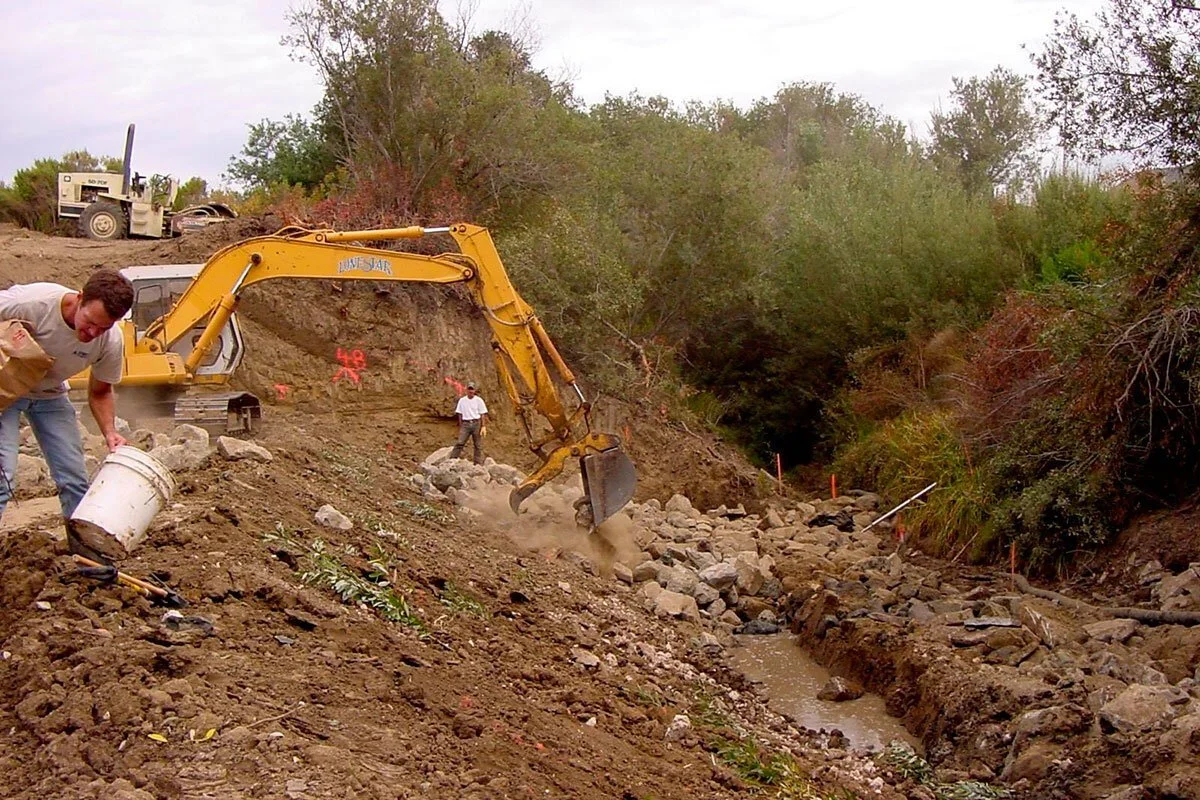Restoration with a Fire Resilience Focus: Riparian Restoration in Goleta Valley to Reduce Fire Risk
Project Brief
Healthy riparian corridors with natural unimpaired hydrology are natural fire breaks, with well watered vegetation acting to catch and extinguish embers and dampen fire advancement. Unhealthy riparian corridors choked with non-native vegetation can have the opposite effect, acting as conduits for fire entering into WUI areas adjacent to development. Water wells and creek diversions can also exacerbate fire hazards by drying out natural flows. A comprehensive assessment of watersheds in Goleta, entitled "Goleta Watersheds and Wildland-Urban Interfaces Enhancing Fire Safety and Riparian Forest Health", prepared by the Environmental Defense Center (click here to view), recommended a suite of restoration efforts to reduce fire risks.
Specific recommendations for the following key project areas are contained in this assessment: Glen Annie/Tecolotito Creek Watershed, Los Carneros Creek Watershed, Devereux Creek Watershed, Maria Ygnacio Creek Watershed, Las Vegas Creek Watershed, San Jose Creek Watershed, San Antonio Creek, Tecolote Creek Watershed, Bell Canyon Creek Watershed, Atascadero Creek Watershed. These recommendations should be prioritized and implemented as soon as funding opportunities and capacity are available. Some of these watersheds are next to areas that are considered vulnerable populations. The nexus between high risk areas and vulnerable portions of these creeks should be a consideration for how to prioritize creeks for restoration.
Project Description
A number of creeks within the City of Goleta (and extending into unincorporated areas) have been identified as areas that would greatly increase fire resilience if they undergo focused restoration to address myriad concerns in WUI areas. Several of these creeks are listed in the recently-adopted Creek and Watershed Management Plan.
After this Plan was approved in winter of 2020, follow-on intensive analysis was conducted by staff at the Environmental Defense Center with support from the Coastal Fund to identify creeks with a direct nexus to fire hazards. Specific details and recommendations (with photographs, partners, and issues that should be addressed) for each creek are contained in Appendix X. These creeks and associated concerns include the following areas:
Glen Annie/Tecolotito Creek Watershed
Cathedral Oaks Road and Glen Annie Road
Los Carneros Creek Watershed
Middle Watershed near Edison Catway Road
Bishop Ranch
Cathedral Oaks Bridge near the Intersection with North Los Carneros Road
Devereux Creek Watershed
El Encanto Creek – Glen Annie Golf Club
El Encanto Creek – Northgate Drive near Glen Annie Golf Club
Unnamed Tributary to Devereux Creek on Calle Real
Sperling Ellwood Mesa Preserve Monarch Butterfly Overwintering Site
Maria Ygnacio Creek Watershed
Numerous portions of the watershed are individually described and recommendations provided.
Las Vegas Creek Watershed
La Goleta Road near Fairview Avenue
La Goleta Open Space on Paseo Palmilla
San Jose Creek Watershed
North Patterson Road Bridge Grouted Rock Embankment
Cathedral Oaks Road and North Kellogg Avenue
Merida Drive to Calle Real
San Antonio Creek
Windy Gap Firebreak North of Highway 154
La Ramada Drive and Turnpike Avenue
Tecolote Creek Watershed
Various recommendations
Bell Canyon Creek Watershed
Various recommendations
Atascadero Creek Watershed
Vieja Valley Elementary School
Tributary of Cieneguitas Creek at La Cumbre Road South of Foothill Road
Tributary of Atascadero Creek at Highway 154 Foothill Road On-ramp
Each of the above-named creeks has specific and detailed recommendations, including identification of jurisdictional and permitting issues, potential partnering agencies, and other nuances that must be addressed to effectuate the project (see full report-Appendix X). Most importantly, each of the projects connects back to the need for restoration to increase the resilience of Goleta to wildfire.
Status: Unfunded
Cost: High
Potential Partners: ENVIRONMENTAL DEFENSE CENTER, CACHUMA RESOURCE CONSERVATION DISTRICT, CITY OF GOLETA, CHANNEL ISLANDS RESTORATION, COUNTY OF SANTA BARBARA
Funding Sources:
Permitting: Projects may require consultation and coordination with the California Department of Fish and Wildlife (CDFW), Cities, and unincorporated County of Santa Barbara.
California Environmental Quality Act (CEQA) documents and other coordination will be needed for work done in creeks.
Certain projects may require a grading permit depending on the amount of cut/fill required.
Coordination with the RWQCB may be required depending on the scope of work.
If dealing with perennial streams, ACOE may need to be involved in permitting.
Tree removal permits may be required from Santa Barbara County.
Work completed in coastal creeks may require a Coastal Development Permit.
If there are federally threatened or endangered species present, United States Fish and Wildlife (USFW) consultation would be required (if a federally-listed species is present).
Restoration projects could be CEQA-exempt, however, this must be determined on a case-by-case basis and proper documentation must be filed with the State Office of Planning and
Research (OPR) that explains why it is exempt, and which CEQA exemption/section would apply.
A programmatic level CEQA document that could incorporate all the identified riparian restoration recommendations in its analysis may be appropriate and beneficial so projects can be addressed comprehensively.
Additional Notes: Many of these projects are under consideration as part of the City of Goleta's Creeks and Watershed Management Plan https://www.cityofgoleta.org/city-hall/planning-and-environmental-review/advance-planning-division/environmental-programs/creek-and-watershed-management-plan. Research and analysis is medium impact as this work can inform about watershed health and fire risk reduction. Overall priority is medium because the risk of wildfire is not as high in urbanized areas. The priority of any given restoration project within this larger plan might by high or very high depending on its location.


